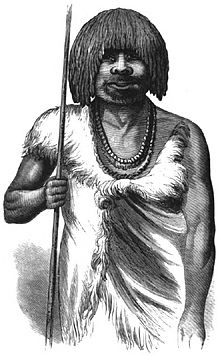Tasmanian Aborigine

Illustration from "The Last of the Tasmanians" – Wooreddy, Truganini's husband
|
|
| Regions with significant populations | |
|---|---|
|
|
|
| Languages | |
| English; formerly Tasmanian languages |
The Aboriginal Tasmanians (Tasmanian: Palawa) are the indigenous people of the Australian state of Tasmania, located south of the mainland. In the 20th century the Tasmanian Aboriginal people were erroneously thought of as being an extinct cultural and ethnic group. However, data from the 2011 census indicated that nearly 20,000 people identify as Indigenous in Tasmania; making Tasmania the state with the second highest proportion of indigenous to non-indigenous people in Australia.
Before British colonisation in 1803, there were an estimated 3,000–15,000 Palawa. The Palawa population was severely depleted in the 19th century. A number of historians point to introduced disease as the major cause of the depletion of the 19th century mainland Aboriginal population.Geoffrey Blainey wrote that by 1830 in Tasmania: "Disease had killed most of them but warfare and private violence had also been devastating." Other historians regard the Black War as one of the earliest recorded modern genocides. Benjamin Madley wrote: "Despite over 170 years of debate over who or what was responsible for this near-extinction, no consensus exists on its origins, process, or whether or not it was genocide". However, "[using the] UN definition, sufficient evidence exists to designate the Tasmanian catastrophe genocide."
By 1833, Christian missionary George Augustus Robinson, sponsored by Lieutenant Governor George Arthur, had persuaded the approximately 200 surviving Aboriginal Tasmanians to surrender themselves with assurances that they would be protected, provided for and eventually have their lands returned to them. These 'assurances' were false, there is no suggestion that Robinson or Lieutenant-Governor Arthur intending anything else but exile to the Furneaux Islands and the assurances were given by Robinson in order to facilitate the removal of the Aboriginal people from mainland Tasmania. The survivors were moved to Wybalenna Aboriginal Establishment on Flinders Island, where diseases continued to reduce their numbers even further. In 1847, the last 47 living inhabitants of Wybalenna were transferred to Oyster Cove, south of Hobart. Two individuals, Truganini (1812–1876) and Fanny Cochrane Smith (1834–1905), are separately considered to have been the last people solely of Tasmanian descent.
...
Wikipedia
